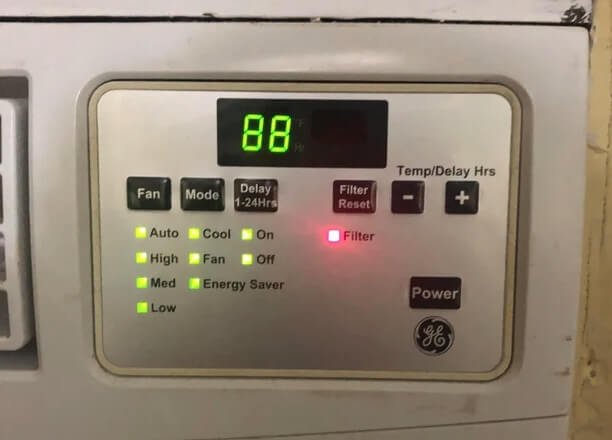
An error code might seem like your AC’s way of speaking in riddles, but it’s actually trying to help you pinpoint a problem. The F1 error code, specifically, typically signals a communication failure between the indoor and outdoor units of your air conditioner. Imagine it like two friends who’ve temporarily lost touch with each other. Don’t worry though; with a bit of guidance, you can help them reconnect and get your AC back on track. Let’s dive into the steps you need to follow and ensure your cool comfort returns as soon as possible.
Understanding the F1 Error Code
To fully grasp what an F1 error means, think of your air conditioner as a well-coordinated orchestra. Each component—compressor, fan, thermostat—must play its part in harmony to provide that perfect ‘cool’ symphony. The F1 code is like a missed note, indicating something’s out of sync. Typically, this stems from a communication issue between the indoor and outdoor units of your GE air conditioner.
Why does this happen? It could be due to various reasons such as a power surge, faulty wiring, or even extreme weather conditions. These factors might disrupt the delicate line of communication between the two units. But don’t fret, this isn’t an unfixable issue. Much like a temporary hiccup, it often just needs a simple reset to get everything running smoothly again.
When your unit displays this error, it effectively hits the pause button on its operation. No cold air will be blowing until this is resolved. So, your first mission, much like a detective, is figuring out how to reset the system and clear the error. Fortunately, you don’t need to be an HVAC expert to do this. In just a few easy steps, you can restore your unit’s functionality.
Step-by-Step Guide to Resetting Your GE Air Conditioner
So, how exactly do you reset your GE air conditioner to clear the F1 error code? Imagine it like rebooting your computer when it freezes. This process is essentially the same concept—simple and straightforward. Here’s the method you should follow:
First, switch off the power supply to your air conditioner. Locate the power switch on your unit or head over to your breaker box and flip the switch for the air conditioner to the off position. Turning off the power ensures safety and prepares the unit for a fresh restart. Think of this as giving your air conditioner a chance to take a deep breath.
Next, wait for a few minutes. This waiting period is crucial because it allows the internal systems to completely power down. Just like when you restart a gadget and give it a moment to clear out the glitch, your air conditioner needs this time to reset internally. Patience is key here; a good five minutes should do the trick.
After waiting, turn the power back on. Either flip the switch on your breaker or press the power button on your unit. Once you do this, you should see the display light up. With a bit of luck, the F1 error code will have vanished. If it doesn’t, don’t panic. Sometimes, repeated tries or checking the physical connections might be necessary.
Additional Tips for Persistent Issues
If the F1 code persists even after a reset, it might be time to delve a little deeper into some potential underlying causes. Imagine your air conditioner as a puzzle; occasionally, a piece might be missing. Here’s how you can address these potential issues.
Inspect the wiring and connections. A common cause of the F1 error is loose or faulty wiring. Carefully examine the connections between your indoor and outdoor units. If you’re not comfortable with electrical components, it’s wise to call a professional. This step is a bit like checking the strings on a musical instrument—they need to be tight and secure to play beautifully.
Consider environmental factors. Your air conditioner might be affected by weather extremes. Ensure the external unit is shielded from direct debris or excessive moisture, which might temporarily disrupt communication. It’s similar to a phone signal getting blocked when you’re in a tunnel; removing obstructions can help re-establish that connection.
Reflect on recent changes in your home’s power supply. Sometimes, power surges or outages can trigger persistent error codes. If this is the case, a surge protector can be a useful addition to protect your unit in the future.
Preventative Measures to Avoid Future Errors
Now that you know how to deal with the F1 error, let’s talk about keeping it from happening again. Prevention is always better than cure, right? Here are some tips to keep your GE air conditioner running smoothly.
Think about regular maintenance as the secret ingredient for longevity. Just like you’d service your car for optimal performance, your AC needs periodic check-ups. Schedule an annual maintenance service with a certified technician to clean, inspect, and tune up your units. This can help catch potential issues before they escalate into error codes.
Another helpful measure is to ensure your air conditioner isn’t overworking. Much like any device, pushing it to its limits can result in errors. Keep your filters clean, move any obstructions away from vents, and don’t set your thermostat too aggressively. This helps maintain a balanced workspace for your AC, preventing it from overheating or over-exerting itself.
Finally, consider environmental control within your home. Using curtains, blinds, or shades can reduce strain on your air conditioner by minimizing heat gain during the hottest parts of the day. This simple step can make a difference in the long run, keeping both your home and your AC cool and happy.
With these tips and tricks in your toolkit, you’re not only equipped to solve the F1 error but also to help prevent it from disrupting your comfort in the future. Here’s to endless days of cool, refreshing air, no F1 codes in sight!